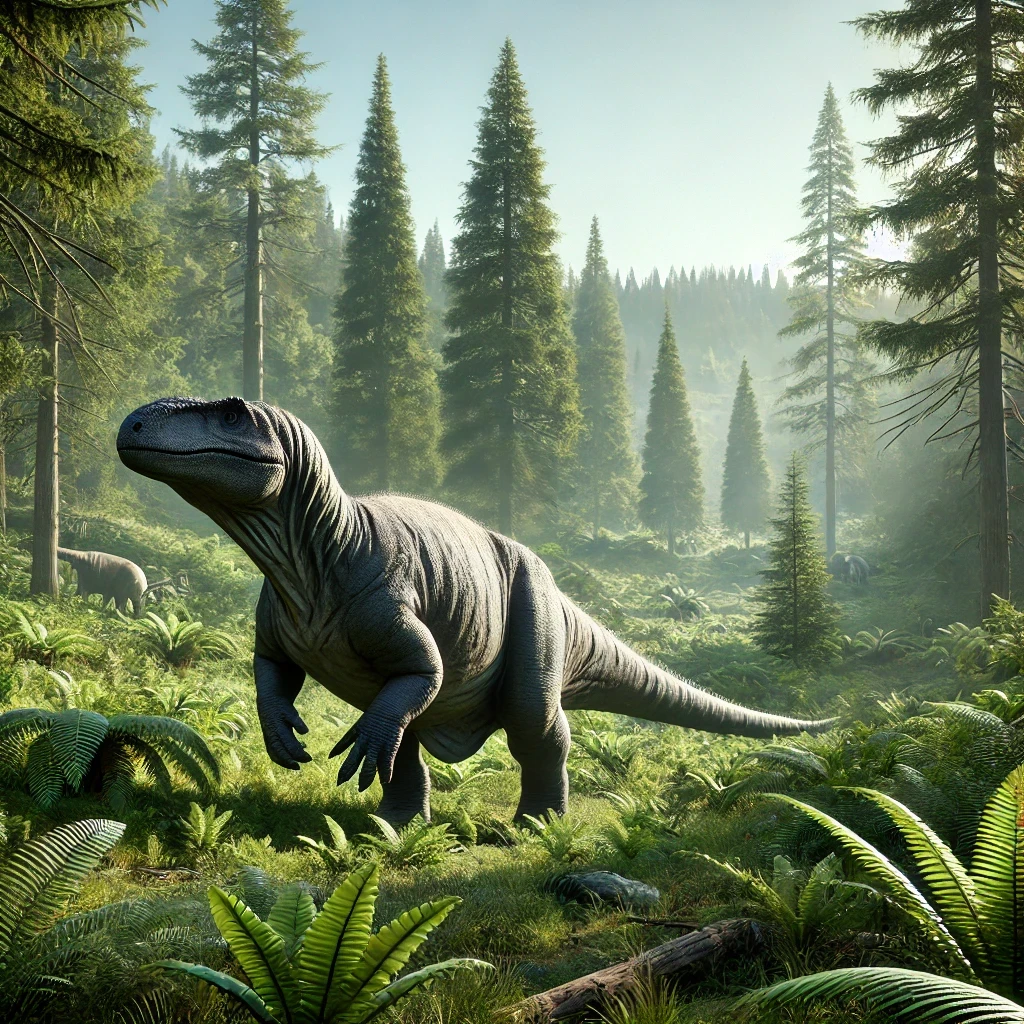Iguanodon
Pronunciation:
Ih-gwah-noh-don
Name Meaning:
“Iguana tooth”
Dinosaur Classification:
- Kingdom: Animalia
- Phylum: Chordata
- Class: Reptilia
- Order: Ornithischia
- Suborder: Ornithopoda
- Family: Iguanodontidae
- Genus: Iguanodon
- Species: I. bernissartensis
Dinosaur Description:
Iguanodon is one of the most well-known and recognizable dinosaurs, largely because it was one of the first dinosaurs ever discovered and named. It was a large herbivorous dinosaur that lived during the Early Cretaceous period, approximately 125 to 113 million years ago. Iguanodon had a unique thumb spike, which is one of its most distinctive features. This thumb spike was likely used for defense against predators or for foraging purposes, such as breaking into tough plant material.
Iguanodon was a bipedal/quadrupedal dinosaur, meaning it could walk on two legs or all fours, depending on the situation. When moving slowly or grazing, it likely used all four legs for stability. However, it could switch to bipedal locomotion when it needed to run or cover large distances quickly. This dual locomotion made Iguanodon a versatile dinosaur, capable of adapting to various terrains.
The dinosaur’s skull was long and relatively flat, with a beak-like structure at the front of the jaws. Behind this beak were rows of grinding teeth, perfect for chewing tough, fibrous plants. Iguanodon was part of the ornithopod group of dinosaurs, which were characterized by their beak-like mouths and specialized teeth adapted for eating vegetation. Fossil evidence suggests that Iguanodon lived in herds, providing further protection from predators.
Iguanodon’s body was robust, with strong hind limbs and a muscular tail that helped with balance when walking on two legs. Its front limbs were also strong, with hands that had four fingers and the iconic thumb spike. Despite its considerable size, Iguanodon was relatively lightweight compared to large sauropods, which allowed it to move more quickly and efficiently.
Dinosaur Diet and Behavior:
Iguanodon was a herbivore, feeding primarily on a diet of ferns, cycads, and conifers. Its strong jaws and specialized teeth allowed it to chew tough plant material, which many other dinosaurs struggled to digest. It likely grazed at ground level but could also reach higher vegetation by rearing up on its hind legs. Iguanodon probably lived in herds for protection, as living in groups could have helped ward off predators.
Dinosaur Size:
Iguanodon could reach lengths of up to 33 feet (10 meters) and stood about 16 feet (5 meters) tall when on its hind legs.
Dinosaur Weight:
Iguanodon weighed around 4 to 5 tons (8,000 to 10,000 lbs), making it a medium-sized herbivore compared to other dinosaurs of its time.
Fossil Discoveries:
Iguanodon was one of the first dinosaurs ever discovered. The first fossils were found in 1822 by Gideon Mantell in England, and it became one of the earliest dinosaurs to be scientifically described in 1825. The most famous discovery occurred in Bernissart, Belgium, where a large number of Iguanodon skeletons were found in a coal mine in 1878. These skeletons were remarkably well-preserved and provided a wealth of information about the species. Since then, Iguanodon fossils have been discovered across Europe and parts of North America.
What Period Did The Dinosaur Live:
Iguanodon lived during the Early Cretaceous period, approximately 125 to 113 million years ago.
Notable Facts or Trivia:
– Iguanodon was one of the first dinosaurs ever discovered and named.
– Its thumb spike is one of its most iconic features, and paleontologists believe it could have been used for defense or foraging.
– Iguanodon could walk both on two legs and on all fours, making it a versatile herbivore.
– Large herds of Iguanodon skeletons were found in a coal mine in Belgium, providing critical insights into its behavior and anatomy.
Scientific Significance:
The discovery of Iguanodon marked a turning point in paleontology, as it was one of the first dinosaurs recognized by science. Its discovery helped lay the foundation for the field of dinosaur research, and its well-preserved skeletons have provided paleontologists with valuable information about dinosaur behavior, physiology, and evolution. Iguanodon has remained a symbol of early dinosaur discoveries and continues to be a subject of research today.
Extinction & Legacy:
Iguanodon became extinct around 113 million years ago, likely due to changing environmental conditions or competition with other herbivores. However, its legacy lives on as one of the first dinosaurs ever named and described. Iguanodon’s discovery helped ignite the field of paleontology, leading to the identification of many more dinosaurs and greater understanding of Earth’s prehistoric past. Its place in early paleontological history ensures that Iguanodon remains one of the most iconic dinosaurs ever discovered.

